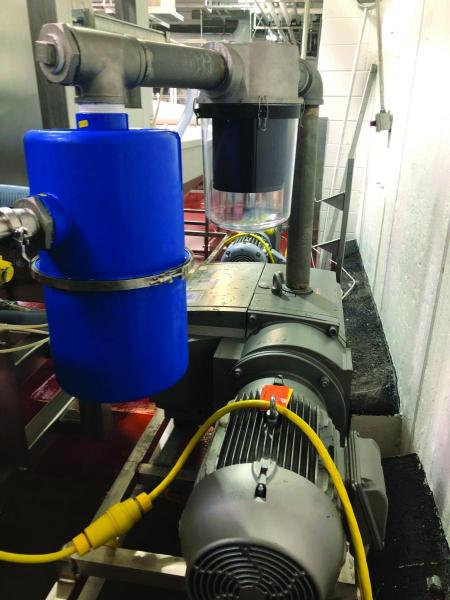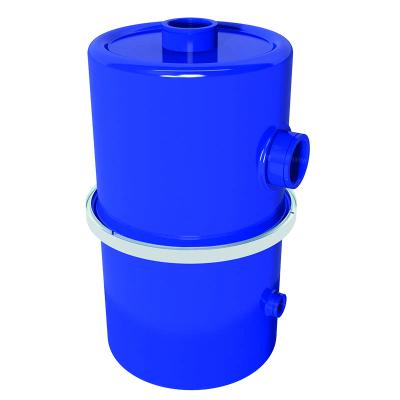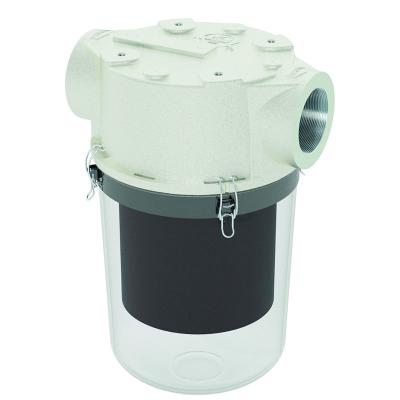Part of the Solberg Manufacturing mission statement is to “innovate and discover new possibilities,” which is what they accomplished in partnership with Becker Pumps Corp. USA when tackling a unique pump and filtration challenge for a meat processing plant. Working together, the companies engineered a total vacuum solution that allows the plant to save millions of gallons of water per year.

An engineered vacuum solution helps a meat processor save approximately 225 gallons of water per minute during a meat-mixing process – and save on wastewater treatment costs.
Vacuum Key to Meat-Mixing Process
Vacuum can be used in many ways for the meat processing and packaging industry. From mixing ingredients to evisceration (removing organs, excess fat, bones, etc.), to the washing/preparation of the meats or even in the packaging of the meat itself, vacuum is critical to the industry.
In this case, Becker’s meat processing customer uses large tumblers/meat massagers to add ingredients to specialty meats like the turkey, chicken, and ham products found in the local deli aisle. This application called for vacuum to be pulled on the tumblers/massagers to help infuse the spices into the meat. The customer has three locations across the United States with a total of 15 tumblers, each one using its own vacuum pump.
The company was spending a significant amount of money on water due to its existing installations of water sealed liquid ring vacuum pumps. Liquid ring pumps can consume large quantities of water when creating vacuum. Using this type of pump technology required the customer to pay for clean water coming in and also the wastewater going back out. In addition to these expenses, the customer needed to ensure the wastewater was “clean enough” to discharge back through the local sewer system adding more cost. One last concern for the customer was that their liquid ring pumps required the incoming water temperature to be maintained at a certain level, or they would risk losing pump performance and fail to meet the vacuum level required for the meat-mixing process to continue trouble-free.
A liquid ring vacuum pump is a positive displacement pump that uses a rotating impeller and a sealing fluid, in this case water, to create vacuum. This technology is well suited for many vacuum applications. However, in today’s world where plant operators are seeking to improve their energy consumption and water conservation practices, alternative vacuum pump technologies are being explored to help achieve environmental and sustainability goals.
Lubricated Vane Pumps: Part 1 of the Solution
The challenge with liquid ring vacuum pumps at the meat processor’s operations is that, while the meat and spice product is being mixed, the vacuum pump can pull pieces of meat/fat, liquids/juices, spice particulate and other contaminants into the vacuum pump. In this application, these pieces of meat, slugs of liquid, and excess spices are pulled through the pump where they are collected and disposed of before the contaminated water is released to the local sewer system.
Decision makers at the meat processing company were concerned about the amount of water they were using to operate their liquid ring pumps and proper treatment of the wastewater prior to disposal. Another concern was the need to properly maintain the water temperature to meet the requirements of the process. After conferring with Becker, the company decided to retrofit their process with Becker lubricated vane pump technology, eliminating the customer’s concerns about water consumption, water temperature control, and wastewater disposal because the pumps require no water to operate.
Becker’s lubricated rotary vane pumps use a sliding vane principle as opposed to a one-piece rotor, allowing them to operate without consuming water. If the rotary vane pump operates at a high enough temperature, the pump can tolerate moisture in vapor form coming from the process because the moisture will stay in vapor form and pass through the pump. However, the rotary vane pump is not designed to ingest larger slugs or sustained droplets of liquid.
Given the harsh nature of the meat-mixing process and the associated heavy contaminant loads, the switch to lubricated rotary vane pump technology places the utmost importance on installing the proper filtration and separation to complete the vacuum system. Specifically, contaminates in the form of liquid slugs/droplets and debris, if ingested into the pump, will interfere with oil viscosity and impact pump performance resulting in poor efficiency and increased maintenance. These ingested contaminants will eventually damage the bearings, vanes, and other working components of the pump. The emulsion of the oil can also potentially create rust on the internals of the pump. Ultimately, it will lead to downtime and costly pump rebuilds.
Knockout Pot and Policing Filter: Part 2 of the Final Solution
Becker consulted with Solberg to determine the solution that would minimize the potential of any issues with installing a lubricated rotary vane pump in the meat-mixing application. Working with the pump curve, application details, and desired outcomes for the project, Solberg and Becker collaborated to formulate a filtration solution that would protect the new lubricated vane pumps and deliver a total vacuum solution for the meat processing company.
The Solberg filtration and separation solution included its LRS series (liquid removal) knockout pot to capture the droplets, slugs of liquid, and seasoning particulate that come in both large clumps and fine dust.

A Solberg LRS Series knockout pot is the first line of defense for a lubricated vane pump used in meat processing application.
The LRS style canister features an integrated mechanical baffle and an expansion chamber, while allowing for significant liquid/slurry holding capacity. It also features a five-micron, polyester filter element rated for 99% efficiency. This system was installed in-between the tumblers and the vacuum pump. The process air leaves the mixing tumblers and flows into the LRS knockout pot, hitting the integrated baffle, which immediately knocks out any liquid slugs and heavier particulate (meat/spice mixture) to the bottom of the canister. Through a change in airflow, the process air is then moved through the filter to collect any of the remaining seasoning dust and then carried out the outlet of the assembly as clean process air. The liquid/particulate sits in the bottom of the filter, to be drained/cleaned out between production runs. The filter can also be easily changed out between production runs.
Since the pump and filtration system was new to the meat processor, the Becker-Solberg team added a “fail-safe” or policing filter to the solution so staff at any operation would know if something was running incorrectly. The ST style inline vacuum trap located after the LRS filter and directly before the lubricated vane vacuum pump utilizes a clear bucket, which allows for visual inspection of the process to see if anything is bypassing the first filter. The same standard five-micron polyester filter element is also used in this housing and acts as a “last line of defense,” or short-term catastrophic failure protection for the pump in case regular maintenance isn’t performed on the first filter.

A Solberg ST inline vacuum filter adds another layer of protection for an engineered vacuum solution installed at a meat processor’s plants.
Saving Approximately 225 Gallons of Water Per Minute
In the end, the customer is highly satisfied with the results. Installed nearly two years ago by the Becker team, the pump and filtration solution saves the meat processor 11-15 gallons of water per minute, per mixer. That translates to roughly 225 gallons of water for each minute the mixers are running, saving the customer millions of gallons of water annually. The solution also saves costs since the company needed to pay for 225 gallons of water coming into the facility and leaving it during every minute the tumblers operated. In addition, the meat processing operations no longer need to maintain water temperatures or worry about the condition of the water that had been pushed down the local sewer system.
Today, Becker continues to install the innovative solution at other meat processing facilities that need a total vacuum solution for similar applications.
About the Authors
Travis Dingee is an Area Manager at Becker Pumps Corp. USA, email: travis.dingee@beckerpumps.com.
Mick Wentzel serves as Southeast Regional Manager at Becker Pumps Corp. USA, email: Mick.Wentzel@beckerpumps.com.
About Solberg Manufacturing
As an international market leader in filtration, separation, and silencing, award-winning Solberg Manufacturing, Inc., based in Itasca, Illinois, is recognized as a trusted partner to its customers, colleagues, and suppliers. Its diverse and highly effective filtration solutions play a role in operations around the globe. Solberg believes that having the proper filtration and separation technology is essential for any businesses operating rotating equipment. After all, the filter completes the system, protecting equipment while also reducing air, noise, and other forms of pollution in the work environment.
The Solberg name has become synonymous with quality in the aerospace, food processing, agriculture, pneumatic conveying, wastewater, medical, power generation, printing, plastics, and other manufacturing industries. For more information, visit www.solbergmfg.com.
About Becker Pumps Corp. USA
Becker manufactures a complete line of oil-flooded and oil-free rotary vane, regenerative blowers, rotary screw vacuum pumps, and low-pressure compressors. These pumps are incorporated into complete central systems and variable frequency drive units to offer an economical and environmentally friendly alternative to standard models. Becker has an internationally networked development team to work with customers on providing equipment manufacturers with the appropriate pump for their application. Manufactured to the highest quality standards in Germany, Becker has brought superior engineering to the global marketplace for over 130 years. Becker pumps can be found on virtually every type of equipment that requires vacuum or pressure. Becker pumps are also predominantly used in many different industries which include food packaging, printing, woodworking, paper converting, cosmetic, pharmaceutical, beverage, dairy, chemical, medical device and consumer packaging. To learn more, visit www.beckerpumps.com.
All photos courtesy of Solberg Manufacturing and Becker Pumps Corp. USA.
To read similar Vacuum System Assessment articles, visit www.blowervacuumbestpractices.com/system-assessments/vacuum-systems.



